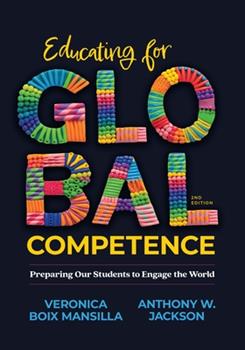Preparing Our Students to Engage the World
Educating for Global Competence: Preparing Our Students to Engage the World 2nd Edition
By Veronica Boix Mansilla and Anthony W. Jackson
(ASCD, 2022 – Learn more)
Reviewed by Megan Kelly

The authors spend the majority of the book breaking down what global competence is: investigating the world, appreciating perspectives, communicating across differences, and taking action. After explaining the elements in detail, they give examples and advice on how teachers can achieve this goal.
Reading through the book, I was pleased to see that my school is on the right track with global competence. The authors emphasize the importance of teachers breaking out of their ‘silos’ and teaching interdisciplinary units. We spend half our year in similar units; the next step is to be intentional on how to transfer their interdisciplinary skills when we aren’t explicitly requiring it.
Help in articulating goals

Educating for Global Competence helped me articulate some of the goals that I have for my students. The authors write that, “Globally competent youth are able to identify, collect, and analyze credible information from a variety of local and international sources, including sources in languages other than their own.”
This feels like a noble call to action when it comes to teaching students about source evaluation – a necessary and, at times, tedious part of teaching social studies. The prospect of using translation tools to consider different perspectives would feel mature to middle school students. I am eager to try this with my students this year.
From the local to the global
I read this book over summer vacation, knowing that Singapore (where I teach) has a presidential election coming up soon. I thought I would touch on the subject in class but hadn’t planned on going into it in great detail. The book includes a chart which states that exploring topics of local and global significance:
- Invite deep engagement.
- Embody local and global connections.
- Embody global significance.
- Invite disciplinary and interdisciplinary grounding.
This inspired me to put serious effort into planning a lesson around the role of Singapore’s president, the election process, and the candidates. I learned a lot in preparing the lesson, and I know my students will be proud to be informed about our host country.
Avoiding charts’ deficit language
An area for growth in the book are the charts that are included throughout from Preparing Our Youth for an Inclusive and Sustainable World: The OECD PISA Global Competence Framework. The charts break down different skills into beginning, learning, and mastering levels, but unfortunately only the ‘mastering’ category has positive and useful language. The other two categories have deficit language which prevent educators from using them to create steps for improvement.
It was a good lesson for me to remember when making my own rubrics. They aren’t helpful tools when only one category states what needs to be done.
The final section of the book features global competence matrices for different subject areas that use asset-based language and are of use to educators as they reflect upon their curriculum.
Usually my summer professional reading texts don’t make the cut for my luggage space on the trip back from New England to Singapore, but Educating for Global Competence is one that I squeezed into my suitcase. There is so much information in it that will help me serve my students throughout the year.
Megan Kelly has been teaching English and History internationally since 2003, most recently in Singapore. She has a Master of Arts in Teaching and is passionate about literacy and learning through play. She tweets at @33megan33. See all her ELA and history teaching tips for MiddleWeb here at her blog Wide Open Learning.


































